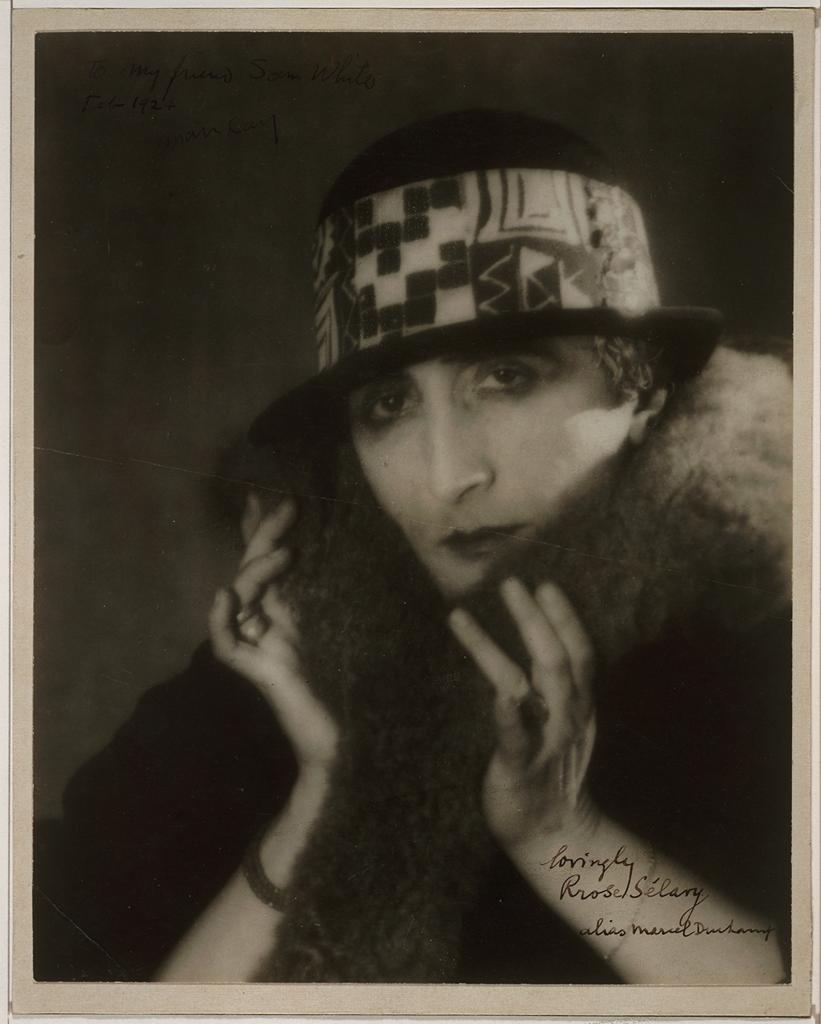Gender
Sophia Boullier

Figure 1. Man Ray, Marcel Duchamp as Rrose Sélavy (1920-21). Gelatin silver print, hand-retouched by Duchamp in black ink and pencil. Smithsonian, Donald W. Reynolds Center for American Art and Portraiture. National Portrait Gallery.
Gender is the socially constructed roles or characteristics attached to biological sex. Gender is not genetically determined, but rather culturally received. It is rooted in institutions and cultural norms that surround us and shape our existence. One may understand the difference between sex and gender through the use of the words “male” and “female” as opposed to “masculine” and “feminine.” The first grouping refers only to physiology and biology while the second describes wider cultural expectations, which may be based on biological attributes but are not limited to them.
The French Dada artist Marcel Duchamp (1887–1968) explored the fluidity of gender through his many performances as Rrose Sélavy, a feminine alter-ego for whom he developed a highly complex background story. Rrose was “born” in New York in 1920. Even more developed was the way in which Duchamp integrated Rrose in his actual life: she signed many artworks, copyrighted Fresh Widow (1920), published The Green Box, founded two businesses, authored journal essays and a book of puns, among other projects.1
Man Ray immortalized Duchamp as Sélavy in a photograph taken in 1920-21. The photograph depicts a short haired blonde woman wearing a luxurious fur-lined coat, a hat with an elaborate Art Deco band, and two rings, one on each hand [Figure 1]. Rrose Sélavy’s relaxed facial expression contrasts with the slight tension and unnatural pose of her hands. Her eyes are fully saturated in contouring makeup, while her lips remain closed and covered in dark lipstick. Her coy gaze aims just above the viewer, seemingly looking off into the distance. Her passive stare could remind the viewer of the traditional representation of women in Western art, a convention for appropriate, non-threatening femininity. In addition to recalling those inherited conventions, his collaboration with Man Ray also points to the constructed nature of all photographs, despite their assumed “truth-telling” power.
The viewer may read “Lovingly, Rrose Sélavy. Alias Marcel Duchamp” at the bottom right corner of the photograph. Rrose flirtatiously signed her photograph. However, Sélavy breaks out of character by designating Marcel Duchamp as her alias and simultaneously catalyzes a debate about gender. Is the artist male with essential feminine qualities, or simply portraying a woman momentarily? Does he consider his identity to be Marcel Duchamp, or is that a male persona he has adopted as well? Her signature doesn’t simply add to the debate on gender but adds dimensions of socio-cultural meaning to the work of art. Through Rrose’s signature, Duchamp transforms into the very embodiment of a gender role, as he establishes his own self as the alias, and Rrose Sélavy as the existing individual. The ambiguity of who is who persists in Man Ray’s title of the photograph, Marcel Duchamp as Rrose Sélavy, emphasizing again the ambiguity of whom embodies the true identity of the photographed subject.
Duchamp reveals femininity and masculinity to be socially constructed, as Sélavy embodies the union of the sexes and their attributes both biologically and culturally. Rrose Sélavy illustrates the unconscious gender performance one must execute throughout one’s lives, as conditioned by societal and cultural norms. Because gender is learned as a result of societal expectations and structures, its powerful hold on human behavior can be effectively questioned by works of art like these.
